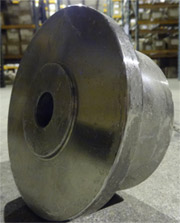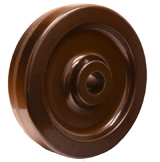The flanged caster wheel is perfect for any situation requiring the use of a track. The flange (whether dual or single) keeps the wheel from jumping off the track during use.
 Flanged wheels set themselves apart from other wheels by having a lip around one or both outside edges of the wheel. Most people will be familiar with flanged wheels as those on trains or old mining carts, however they are popular for many industrial and factory setting applications.
Flanged wheels set themselves apart from other wheels by having a lip around one or both outside edges of the wheel. Most people will be familiar with flanged wheels as those on trains or old mining carts, however they are popular for many industrial and factory setting applications.
The use of a track with a flanged wheel can provide several advantages over a standard wheel rolling on the floor. The floor itself will see less wheel wear, and the caster unit and wheel will have less chance to pick up debris on the floor. Flanged wheels also provide tracked workflow to maintain controlled mobility as well as providing the ability easily raise or lower the work.
Another distinct advantage is the ability of the flanged caster to bring the work overhead. A good example of this is on cranes and hoists that use flanged wheels to roll on an I-beam.
Check out our flanged wheel page for more information!
